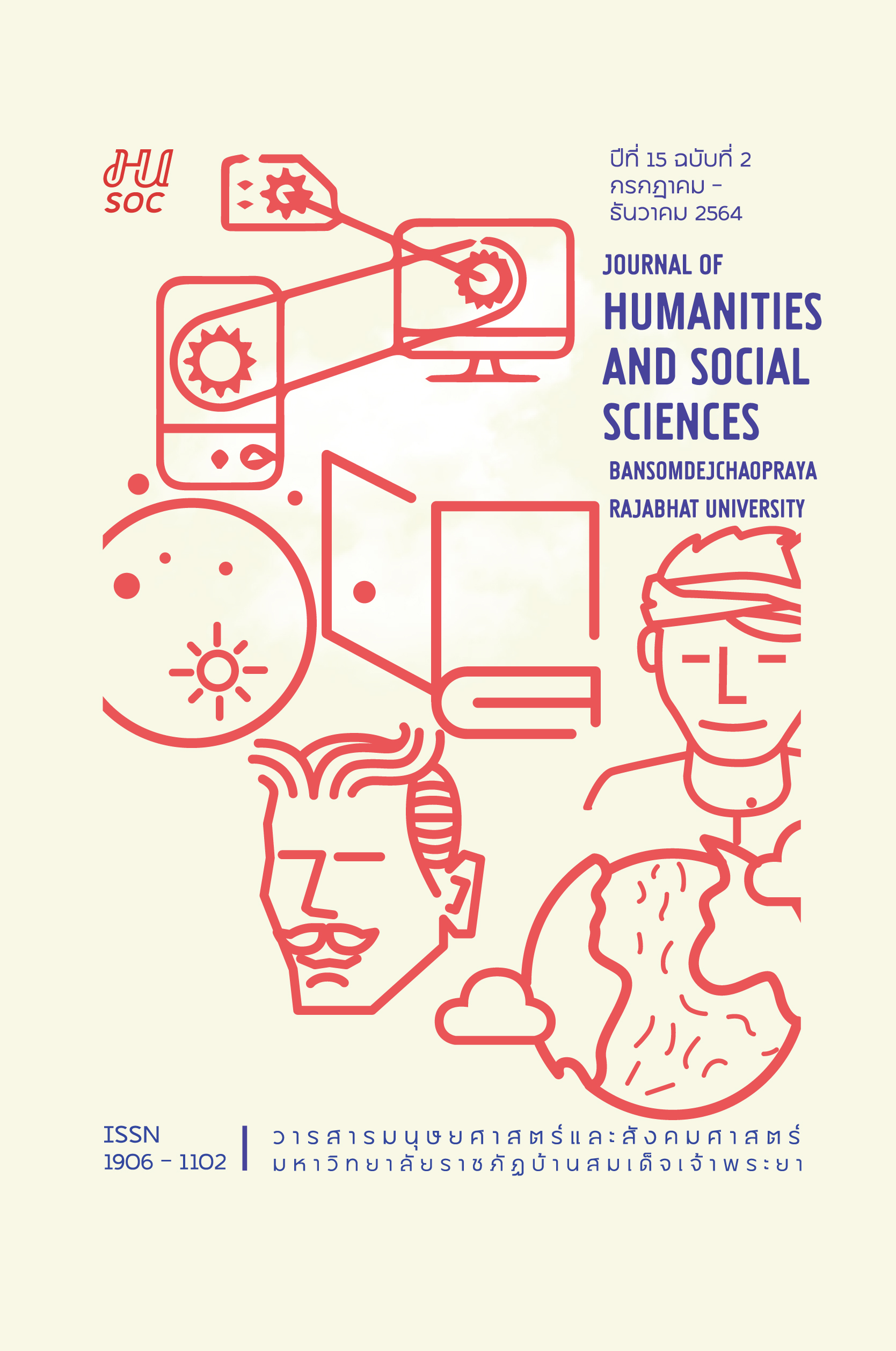The Buddhist Dance: The Creation of a Dancing Art in Contemporary Buddhist Society Context; The Buddhism, Faith and The Yellow Robe
Keywords:
The Buddhist Dance, The Creation of a Dance, Contemporary Society, Buddhist, BuddhismAbstract
This paper is part of the research on The Buddhist Dance: The Creation of a Dancing Art in Contemporary Buddhist Social Context; The Buddhism, Faith and the Yellow Robe. The qualitative research methodology is used by studying data from textbooks, research papers related to the dancing art and Buddhism, and religious issues in the present society. The purpose of this research is to study the body of knowledge on the creation of dancing art and to create a dancing art from a contemporary social context of Buddhism, faith and the yellow robe.The result from the analysis of data reveals that the body of knowledge and the dance creation approach from the contemporary social context in Buddhism can be divided into 8 parts, including the 9 points of considerations before the completion of the performance, resulting in this paper on The Buddhist Dance: The Creation of a Dance in Contemporary Buddhist Society Context;The Buddhism, Faith and the Yellow Robe. This paper is divided into 3 chapters and 12 parts, derived from the Truth of Human Life:dukkha, anicca and anatta. Presenting Buddhist philosophy through dance has led to a new finding - the power of communication through a performance without dialogue or direct verbal persuasion can still allow people to interpret the meaning from the art, leading to discussions, questions or finding solutions that are mutually beneficial.
References
กาญจนาณัฐ ประธาตุ. (2560, พฤษภาคม – สิงหาคม). พระพุทธศาสนากับสังคมไทย: การยืนหยัดและท้าทายในรอบทศวรรษ (พ.ศ.2548-2558). Journal of Arts Management, 1(2), 103-118.
จินตนา สายทองคำ. (2561, มกราคม – มิถุนายน). กระบวนการสร้างสรรค์งานนาฏศิลป์ ชุด สักการะเทวราช. วารสารวิจัยและพัฒนา มหาวิทยาลัยราชภัฏสวนสุนันทา. 10(1), 103-118.
จุติกา โกศลเหมมณี. (2556, กรกฎาคม – ธันวาคม). รูปแบบและแนวความคิดในการสร้างสรรค์งานนาฏยศิลป์ไทยร่วมสมัยของนราพงศ์ จรัสศรี. วารสารสถาบันวัฒนธรรมและศิลปะ, 15(1), 153-159.
ญาณิศา บุญประสิทธิ์. (2559, มกราคม – เมษายน). นาฏศิลป์: สื่อเพื่อการประชาสัมพันธ์ และเผยแพร่วัฒนธรรมไทยในเวทีประชาคมอาเซียน. วารสารศาสตร์มหาวิทยาลัยธรรมศาสตร์, 9(1), 183-214.
ฐาปนีย์ สังสิทธิวงศ์. (2561). การแสดงในองก์ที่ 3 ดับไป. [ภาพถ่าย]. สาขาวิชานาฏยศิลป์ คณะศิลปกรรมศาสตร์ มหาวิทยาลัยศรีนครินทรวิโรฒ.
ฐาปนีย์ สังสิทธิวงศ์. (2561). เครื่องแต่งกายนักแสดง. [ภาพถ่าย]. สาขาวิชานาฏยศิลป์ คณะศิลปกรรมศาสตร์ มหาวิทยาลัยศรีนครินทรวิโรฒ.
ฐาปนีย์ สังสิทธิวงศ์. (2561). ภาพการจัดแสงให้อุปกรณ์เด่น. [ภาพถ่าย]. สาขาวิชานาฏยศิลป์ คณะศิลปกรรมศาสตร์ มหาวิทยาลัยศรีนครินทรวิโรฒ.
ฐาปนีย์ สังสิทธิวงศ์. (2561). ภาพการจัดแสงให้แสดงเด่น. [ภาพถ่าย]. สาขาวิชานาฏยศิลป์ คณะศิลปกรรมศาสตร์ มหาวิทยาลัยศรีนครินทรวิโรฒ.
ฐาปนีย์ สังสิทธิวงศ์. (2561). ภาพการแสดงในองก์ที่ 1 เกิดขึ้น. [ภาพถ่าย]. สาขาวิชานาฏยศิลป์ คณะศิลปกรรมศาสตร์ มหาวิทยาลัยศรีนครินทรวิโรฒ.
ฐาปนีย์ สังสิทธิวงศ์. (2561). ภาพการแสดงในองก์ที่ 2 ตั้งอยู่. [ภาพถ่าย]. สาขาวิชานาฏยศิลป์ คณะศิลปกรรมศาสตร์ มหาวิทยาลัยศรีนครินทรวิโรฒ.
ฐาปนีย์ สังสิทธิวงศ์. (2561). สรุปองค์การแสดงนาฏศิลป์สร้างสรรค์พุทธศาสน์นาฏกรรม: พุทธศาสน์ศรัทธา ผ้าเหลือง.[ภาพถ่าย]. สาขาวิชานาฏยศิลป์คณะศิลปกรรมศาสตร์ มหาวิทยาลัยศรีนครินทรวิโรฒ.
ฐาปนีย์ สังสิทธิวงศ์. (2561). สรุปองค์ความรู้การสร้างสรรค์นาฏศิลป์จากบริบทสังคมร่วมสมัยในพระพุทธศาสนา. [ภาพถ่าย]. สาขาวิชานาฏยศิลป์ คณะศิลปกรรมศาสตร์ มหาวิทยาลัยศรีนครินทรวิโรฒ.
ธรรมรัตน์ โถวสกุล. (2543). นาฏยประดิษฐ์ในงานโครงการนาฏยศิลป์ ของภาควิชานาฎยศิลป์ คณะศิลปกรรมศาสตร์ จุฬาลงกรณ์มหาวิทยาลัย ปี พ.ศ. 2534-2541. กรุงเทพฯ: จุฬาลงกรณ์มหาวิทยาลัย.
ศราวุธ จันทรขำ และอนุกูล โรจนสุขสมบูรณ์. (2563, กรกฎาคม – ธันวาคม). นาฏกรรมกับพระพุทธศาสนาในล้านนา. วารสารมหาวิทยาลัยนราธิวาสราชนครินทร์ สาขามนุษยศาสตร์และสังคมศาสตร์, 7(2), 16-32.
สุรพล วิรุฬห์รักษ์. (2554, พฤศจิกายน). คีตกรรมในพระพุทธศาสนา. จดหมายข่าวราชบัณฑิตยสถาน, 21(246), 7-8.
สุรพล วิรุฬห์รักษ์. (2555, กรกฎาคม – ธันวาคม). นาฏยทฤษฎี. วารสารราชบัณฑิตยสถาน, 39(3), 103-135.
Downloads
Published
How to Cite
Issue
Section
License

This work is licensed under a Creative Commons Attribution-NonCommercial-NoDerivatives 4.0 International License.




